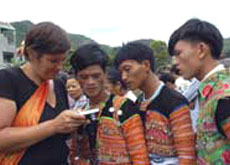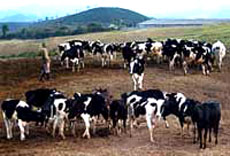
While northern dairy producers in Hanoi, Tuyen Quang and Quang Ninh are dealing with fallout from the recent "melamine storm", farmers in Son La Province’s Moc Chau plateau – the nation’s leading dairy region – have found a unique way to promote sales and tourism by offering "fresh milk tours".
"This may be the perfect long-term economic orientation for local farmers," said Moc Chau Dairy Joint Stock Co deputy director Pham Van Nhan.
The idea occurred to leading local farmer Lam Thanh Tran – known as "King of the Cows" – when he recently received some unexpected guests, a group of young people from Hanoi who wanted to stay overnight at his farm, help him milk his dairy herd, and then buy fresh milk.
"We aim to offer visitors a chance to taste fresh milk just out of the cow and other fresh dairy products like butter," Tran said.
Another farmer in the area, Pham Van Te, also hosted Tran Tien Lam and his two young sons from Nam Dinh with the same purpose.
"We have traveled to a lot of places," said Lam," but this time I wanted to come here to let my children see cows being raised."
Rather than get a hotel room, Lam asked Te if he could camp on the farm. Te agreed, and the family cooked their dinner over a campfire and slept in a tent.

In the morning, the boys got up early and took buckets to follow their host to milk the cows.
Tasting the fresh, raw milk, Tran Duc Thang, 10, squealed with delight. "I have never tasted such a sweet glass of milk. It’s so delicious and fatty!"
"Many visitors recently have asked to camp on the grass like that," Te said, noting than as many as 50 local farms have begun hosting tourists... and making a profitable side-business out of it.
"King of the Cows" Tran said he gets an average of VND 200,000 (USD 11.8) from visitors.
According to Nhan, Moc Chau Plateau, at about 1,050m above sea level and with a mild climate, offers expansive pastures, hills under cultivation with tea, and mountains and caves to explore, and is beginning to combine dairy-farm tourism with other plans to develop tourism.
It may not be as romantic or alluring as Sa Pa in the northern province of Lao Cai, or Da Lat in the Central Highlands province of Lam Dong, but Moc Chau Plateau is verdant with grass, tea and, in the spring, colourful apricot and plum blossoms. With white spots like snow in the trunks of plum trees and lonely houses nestled in valleys, Moc Chau offers its own atmosphere of dreamy mystery.
Nguyen Minh Duc, head of the Moc Chau Ecological Project Control Department, told Viet Nam News that a 442 ha area had been allotted for development of a resort area with a golf course blended into the Moc Chau dairy farm area.
The area’s Bo Nhang site would include a multi-purpose sports training centre and a healthcare centre, he said, while the Chieng Yen site would offer hot mineral springs and a cruise on the reservoir of the Hoa Binh hydroelectric project.
A 4.7 km road into the area was about half-complete, he added, and over 20 domestic partners have registered to invest in various aspects of the project.
"The province aims to preserve a certain area for agriculture and avoid disrupting the lives of local people while, at the same time, encouraging more farmers to take advantage of tourism," Duc said.
Sinh Cafe’s Tran Cong Trinh, who oversees northern routes for the tourism company, said the area was still only a stopover for tourists exploring more established tourist destinations in Hoa Binh, Dien Bien, Cao Bang and Lao Cai provinces.
"Although the area has rich tourism potential, the various sites are located rather far away from one another," Trinh said. "For instance, the mountains and caves are far way from the notorious Son La Prison ruins, where the French held Vietnamese revolutionaries captive."
A guide from the Hanoi-based Vinatour company also noted that few foreign tourists have shown special interest in Moc Chau.
"The area is not well-promoted and local infrastructure is not good enough for developing tourism," she said.
Moc Chau Town is surprisingly bustling and urbanized in light of its location on a grassy, windswept plateau. But it’s well worth a visit every September 1, when the Love Market takes place.
Part of the traditional festival of the Mong ethnic people, the Chau Moc Love Market brings together members of various Mong groups like the Mong Do (Mong wearing white), Mong Du (black), Mong Si (red), and Mong Lenh (flowery). Other ethnic groups, like the Dao, Kinh, Kho Mu, Muong and Thai also come to enjoy the festival.
Similar to the Khau Vai Love Market in Meo Vac in the northern province of Ha Giang, many Mong youth gather in the hopes of meeting their mates, while older people look forward to the market for an opportunity to say hello to old friends.
Young people change into traditional clothes and take along cassettes, playing recorded songs to lure partners. Men wait in a long queue for a haircut, while others invite women to eat with them or pose for photographs together.
Many Mong families arrive at the market together, but, once reaching the market, each family member goes his or her own way. They stay into the night meeting, chatting, eating, drinking and singing with their friends.
Although the market is thronged with drinkers and carousers, there are no quarrels or conflicts, which are surprising in light of the Mong saying, "After the market, if you are not drunk, you are not sincere."
Early the next morning, families meet up again and head home together.